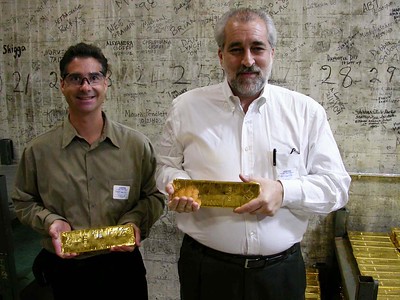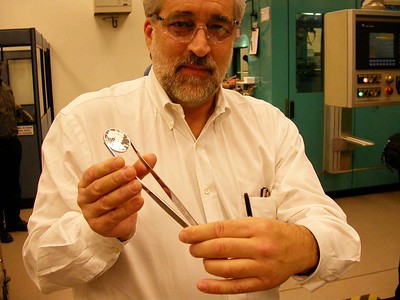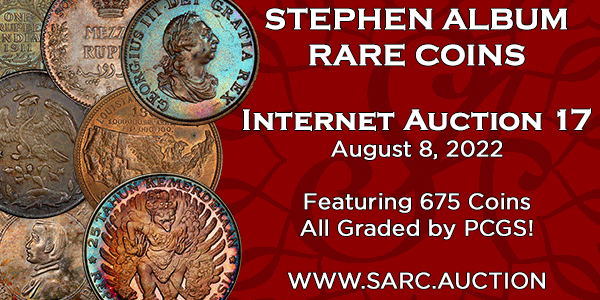
PREV ARTICLE
NEXT ARTICLE
FULL ISSUE
PREV FULL ISSUE
V25 2022 INDEX E-SYLUM ARCHIVE FRED WEINBERG INTERVIEW, PART THREEPublished in Errorscope earlier this year, Greg Bennick's interview with dealer and longtime E-Sylum supporter Fred Weinberg is a wonderful look at the hobby and business of error coin collecting over the last half century. With permission from the Combined Organization of Numismatic Error Collectors of America (CONECA), we're republishing it here. Here's part three of four, where Fred discusses some of his favorite major error coins. -Editor
Fred Weinberg: There were articles that said the Secret Service would confiscate them, and once or twice the Secret Service did, but it turned out that it was mostly false alarms. The Secret Service rarely did that. So I never worried about it. As far as specific coins, I mean I can think of two that pop off the top my head. One which has to do with the Bolt Collection, and then another one which is another fascinating coin. Let me tell you about the first one. So in this Bolt Collection there was there was a Gem 1919 Standing Liberty Quarter broad struck on a type one blank that was the size of almost a half dollar. It was spectacular. There was also a 1895 $5 gold piece, 30% off center at 12 o'clock. Gem BU, semi proof like surfaces. I mean there were half cent, large cent errors, off metal type coins. Just incredible material. One of my favorite coins was an 1888 Liberty nickel with a brass coil struck into the reverse of the coin. And the coil looked like a coiled snake and it had the design of the reverse of the Liberty nickel. If you lifted it up, there was the indentation of where the coil was. That was a two piece set, it was fascinating. And to this day, no one's ever seen a struck in screw or piece of metal or coil on any type coin. All that stuff didn't start happening until the 1960s. So there's a fascinating story with this coin, I loved the piece. I advertised it for $600 in Coin World. And somebody from Connecticut bought it out of that Coin World ad. This party had never bought an error coin from me before, never bought an error coin after. That coin never surfaced again. But I never stopped thinking about that coin and the coil.
It was 1974 when I sold it. Fast forward to 2010, and I was at the Boston ANA. I saw Bill Fivaz one
morning as we're walking over to the coin show and he said, That particular coin is now in a two-piece PCGS holder with my pedigree on it, and that will be sold at the Central States Auction of my personal error coins. So that to me is a fascinating piece. It's something that I bought in ‘74, couldn't forget about it, bought it again in 2010, and now it'll be sold in 2022. Greg Bennick: That's an incredible story. I'm so excited you shared that.
Fred Weinberg: It's a great item. The other coin, I just find it fascinating. I started working Numismatics Ltd in
early ‘72, and worked for Harry Gordon -- I was hired to do rare coins, but he knew I played with errors, and so
he said,
A few months into my working there I got a mimeographed ad, which is how most dealers sent out their
inventory at the time, from a gentleman in Cincinnati named Sol Kaplan. He and Abe Kosoff, Jerry Cohen and
Abner Kreisberg, these were guys from the 1940s and ‘50s who were getting older in the 1960s and had
played with coins. Sol Kaplan was a big time dealer in Cincinnati.
So I was looking at his list of rare coins and silver dollars and everything. I got to the last page of the
mimeograph and at the bottom it said, I bought the coin for $1000 and I sold it for $2500. A couple of years later I bought it back for five grand. I sold it for $7500 to Mark Lighterman, who's a very famous collector in Florida who has probably the best collection of off metal and wrong planchet US coins. Mark still has that coin. He brought it to the FUN show maybe four years ago now, and I saw it there for the first time since the late ‘70s. I love that coin. To get a wrong planchet off metal US gold coin is extremely rare. And that coin today is probably easily worth a quarter of a million dollars. Greg Bennick: Unbelievable. Is there any coin that got away? Meaning one that you regret? Fred Weinberg: Yeah, that one. [laughter] I owned that coin two or three times. I wasn't smart enough to keep it for myself! Greg Bennick: Are there pieces that you never owned but just loved from afar? Like you know that they exist in the world, but you never had a chance to own them?
IMAGE: Dave Camire from NGC and Fred Weinberg. Photo was taken at the West Point Mint in 2009, in the Gold Cage room. -Editor Greg Bennick: One thing that I appreciate about you and always have, and that I have heard people mention about you as well, is that any time we've ever talked at a show or on the phone, you have a little kid awe and fascination about you, about error coins. You still have that after all this time in the hobby. It's inspiring. Fred Weinberg: Well thank you. And you know what, that's part of why I say I've never had a boring day in the coin business. I thought I would be doing this all my life. I literally did, up until a few years ago. And now there's a half a dozen reasons why I want to retire. But I've always loved coins, I've never been bored with them. And every day has been something new or something different. It's been a wonderful hobby that I turned into a profession. Not too many people can turn a hobby into a profession for 50 years. Greg Bennick: It's true. Just in case people are curious, of those half a dozen reasons, are there any public reasons as to why you're retiring at this time, given that your energy and excitement about coins is still so high? Fred Weinberg: There's no secrets. In no particular order, my reasons are, number one, this is my 50th year, which caused me to reevaluate everything. Number two, I'm going to be 72 in a couple of months. That's a reason to think about retiring. Number three, I've reconnected with my very first girlfriend from 50 years ago, and we're deeply in love. She happens to live in Asheville, North Carolina. So, between her living there and the virus, it's been hard. We try to see each other like every other month if possible. And, a lot of my decision was, my mother passed away at 96 about three years ago, and going through her house and all of her stuff made me realize -- this is maybe reason 6.5 -- as an error dealer, not just a coin dealer, but as an error dealer, I have so many strange things here in my office that if I passed away, there would be an incredible burden and stress on my daughter, and Kathy, my assistant, who's been with me for 37 or 38 years, to get rid of this stuff. They wouldn't know what to do. So between 50 year anniversary, turning 72, reconnecting with my first girlfriend, and also even a year ago, starting to think, you know what, do I really want to continue traveling to coin shows, where I'm going to a convention center in Florida, Chicago, Texas, whatever it is, where I don't know who's vaccinated? I don't know who's wearing a mask? In my seventies and eighties, do I want to expose myself to that, to sell another double struck penny? It was a confluence of all of those things, plus the cherry on the pie being that in selling all this stuff, the coin market obviously is surprisingly strong right now. I don't think people would have thought it would have been as crazy as it's been for all of 2021 and even for 2022. So this hot market, because of all the money floating around in the economy, whether it's artwork or NFTs or rare coins or trophy coins, the coin market on almost every level is very very strong. This market will soften, whether it's two years from now or four years from now, and then it's going to take a couple of years of a dull flat market, and then it's going to take another couple of years for the market to start to work its way up, though in another couple of years the market will be hot again. I thought about it and I said, why not take advantage of an existing market that I know is good, rather than say, well, I'll wait for the next good market that may or may not appear until 8 to 10 years from now? So, all of those reasons, Greg, are why I decided to retire and to basically sell most of my collectibles. In addition to all of my coins that Heritage has, they also have a collection of over 200 psychedelic rock posters from San Francisco, Avalon, and Fillmore that I started collecting in the early 1980s that to some degree, I'm more excited to see what they bring. Because I know what the coins will bring within a general range. But some of these posters have not been on the market in decades, and some of them are really good condition, and that's going to be sold in April, along with my coins, at the Central States show. I'm looking forward to seeing what these posters bring. Greg Bennick: That's really exciting! Just out of curiosity, I never even thought to ask you, what other things do you collect and are you interested in?
Fred Weinberg: You mean as far as non-numismatic or non-coin things? I would say that the posters to a
degree. And if I had to think of what else, I just like collecting ephemera. Heritage also has a lot of stuff that I
had a lot of fun buying. Whether it's US Mint canvas bags, or very early US Mint reports, or letters from the
Treasury or letters from the US Mint talking about coins or different things. I had a book from the Philadelphia
mint that listed how much pay every person got in the 1870s and 1880s, including George Morgan. I liked
collecting what I call Greg Bennick: That's great. In terms of ephemera, my living room is literally piled with paper and ephemera from your collection that I've purchased recently. I bought a full run of Errorscope, a full run of The Penny, a full run of the Mint Error Collectors Bulletin, along with a couple hundred issues of Errorgram and Error Variety News. I'm going to spend the next few years reading through all that. The history of the hobby is fascinating. Fred Weinberg: You'll probably run across two dealers named Phil Steiner and Mike Zimpfer. They did a book called Modern Mint Mistakes, which is kind of like Error Trends, telling how US coins are made, and showing coins. They were also very, very big dealers. And they made a major impact on the industry from the late ‘60s to the early to late ‘70s and then they kind of just disappeared. I know one of them was a schoolteacher, but I really don't know what happened to either one of them. But Steiner and Zimpfer, came out with a good book on coins with a lot of pictures which everybody liked at the time. Greg Bennick: I do know it. That book was immensely influential on me. Fred Weinberg: I tell people, part of what's made the error hobby so big nowadays, is that when I started, all you could see was Collectors Clearinghouse, and of course that was just a couple pages in a newspaper with black and white pixelated pictures of an off center or double struck penny or something like that. But with computers and the internet now -- and this is what I honestly believe this really helped stimulate the error hobby in the last 20 years - you go to a Heritage or Stack's website and you look up a coin, and of course the images are huge, and in color, with data about what is being sold. The visual impact is just incredible. So there's good and bad to that. The good news is, whether it's eBay or Heritage or even my website when I had my inventory up, major error coins made an incredible visual impact on computer screens, which really excited people. I got that feedback all the time. That's the good news and that helped expand the error hobby, and made people excited to buy coins. A mimeographed piece of paper with a black and white picture that you couldn't really tell what it looked like, didn't get people excited. Now you can see the spots, and a mark, and you can tell the luster, and you can see everything. So computers have really, really helped errors. That's all the good news.
The bad news is basically the flip side of that. Because of computers, anybody that finds anything in
their pocket change or roll hunting searches that looks different, either they automatically assume it's an error
and worth a fortune, or, what I've been finding and it's been very frustrating just the last few years, is that they
start their own website. And they'll either take a damaged coin and say it's worth $1,000 or take a genuine
error coin and say it's worth $10,000, and they put it on their website. And I then dealers across the country,
get phone calls and emails that say things like,
I've always taken the approach that it's my responsibility as an error dealer to let people know what
they have. In the old days, I would answer any email at least three times. In the original reply,
I mean I have to defer people, because people think that you have nothing better to do all day in your
business but to spend ten or twenty minutes talking about their coins. And when I keep on saying to them,
For more information about CONECA, see:
To read the earlier articles in this series, see:
Wayne Homren, Editor The Numismatic Bibliomania Society is a non-profit organization promoting numismatic literature. See our web site at coinbooks.org. To submit items for publication in The E-Sylum, write to the Editor at this address: whomren@gmail.com To subscribe go to: https://my.binhost.com/lists/listinfo/esylum All Rights Reserved. NBS Home Page Contact the NBS webmaster 
|



